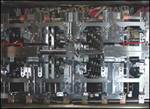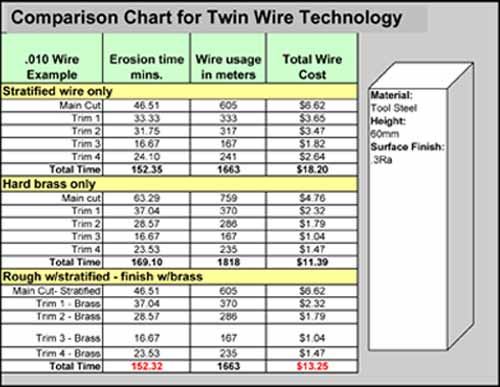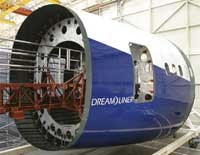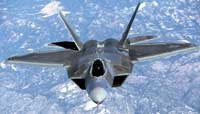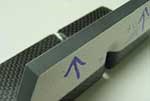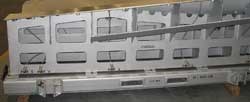Surging Demand for Composites Creates Opportunities for Moldmakers
Metal fabrication skills meet needs of composites manufacturing in a range of high-tech operations.
Business is booming in aerospace and defense, fueled by record demand for aircraft and by advances in weapon systems that are remaking military capabilities.
One technology that’s playing a growing role in both industries is composites, typically carbon or glass fiber-reinforced thermosets and thermoplastics and multi-material laminates like aluminum mesh and glass fiber. These materials are essential to the performance, longevity and life-cycle benefits of applications.
Composites have become mainstream materials in many aerospace and defense programs, and their use creates opportunities for moldmakers who are more accustomed to building injection molds than wing spars, missile casings or radomes. This is because moldmakers can apply many of their skills in metal fabrication to composites manufacturing.
Demand for Machining
Obvious areas of expertise include making metal tools and fixtures for operations like reaction injection molding, compression molding and resin transfer molding, open-mold processes like prepreg lay-up and vacuum-bagging, or autoclaving.
There also is the need for high-speed machining of near-net-shape parts after they are formed by processes like filament winding or tape-laying, to meet tight design tolerances. Machining composite parts is, in fact, the operation experts say offers the most potential to moldmakers, since demand in aerospace and defense has reduced available capacity among the traditional suppliers to these industries.
“The composites market will continue to grow and expand, and there are not enough sources of supply for machining components,” says Jim Hickman, Director of Business Development at Stadco (Los Angeles, CA), a company specializing in high-tolerance parts and molds for aerospace. “Moldmakers with machining capabilities for metallic parts should be able to do an excellent job in composite machining.”
Another big plus for moldmakers is their familiarity with automation. Despite growing use, composites remain expensive. Graphite-reinforced grades with ultra-high-performance resins can cost more than $100 per pound. Automating composite manufacturing—setup, fabrication and finishing—helps reduce process cost.
Some suppliers of machining centers, cutting tools and software are expanding offerings for the market. Developments include adapting machining systems for composites, designing effective cutting tools and writing software that meet a range of fabrication needs.
In a related area, suppliers are promoting equipment for machining hard metals like titanium and invar alloy, materials that are prominent in aerospace manufacturing—titanium for aircraft components and invar, whose low thermal-distortion properties maintain part tolerances to thousandths of an inch, for molds.
Stadco, in fact, has developed a process for electron-beam welding of invar tubing for use as a substructure in molds for composites. The benefit, Hickman says, is that the tubing improves airflow through the tool, so it heats and cools faster. It also strengthens the tool and reduces its weight. Stadco uses the tubing for its own work and sells it to other tool builders.
The opportunities for moldmakers in composites fabrication are very new and not always apparent to mold shops and suppliers. But there is little doubt about the demand for composites in aerospace and defense, which is confirmed by statistics that justify the enthusiasm companies have for the market.
Aircraft Programs Drive Growth
The aerospace and defense sector in the U.S. posted a 22 percent gain through the third quarter over the same period last year. Much of this is attributable to aircraft programs that are heavy users of composites for their high strength-to-weight ratio, design flexibility, damping characteristics, resistance to corrosion, fatigue and impact, and, in the case of military platforms, stealth properties.
Composite structures also resist cracks better than metallics. Joe Slusarcyk, Project Engineer at the National Center for Defense Manufacturing and Machining (NCDMM), says cracks that develop in composites do not become larger as in metals, because fibers impede their length.
The NCDMM (Latrobe, PA) was formed by industry and local government to improve manufacturing processes for the Defense Dept. and its industrial base.
Recent advances in fabrication technology are moving composites from secondary applications on aircraft to primary structures, where they are used to build entire wing assemblies, fuselages and cockpits.
Aviation is one reason software provider Delcam (Salt Lake City, UT) estimates that the composites market, which it values at $15-$20 billion worldwide, will grow 3 to 5 percent annually for the foreseeable future.
The good times may roll on to 2026. According to aircraft manufacturer Boeing Corp., global demand for civilian passenger and cargo airplanes will increase to 36,420 in 2026 from 18,230 in 2006—a gain of virtually 100 percent.
Experts credit Boeing and its rival Airbus with driving demand for composites through major aircraft programs: Boeing with the 787 Dreamliner, Airbus with the A350 XWB (“Xtra Wide-Body”). The 787, scheduled for delivery in late 2008, became the first airliner to utilize a large percentage of composites in its construction—50 percent by weight. The A350, redesigned after Boeing announced the 787, will reportedly incorporate more than 60 percent composites by weight. Initial A350 deliveries are planned for 2013.
Both aircraft have had their share of delays and missteps, but are exerting a long-lasting impact on composites design and fabrication.
“Airbus and Boeing believe they are driving the leading edge of composites technology,” says Bill Hasenjaeger, Product Marketing Manager at software developer CGTech (Irvine, CA). “They’re not afraid to invest money in developing the technology, even though it’s not something they might use. They invest because it will help them build their products.”
Indeed, many companies with equipment and software developments for composites say some of these came about during work for Boeing.
The main fabrication techniques Boeing is using for the 787 involve prepreg lay-up of the wings in molds and automated tape-laying of the cockpit and multiple fuselage sections, all of which are joined together during assembly. The company cites various benefits from composites, beginning with construction. Boeing says that because sections of the aircraft are manufactured prior to assembly, it takes 2,000 workers three days to build a 787 compared to the 21 days it would take the same number of workers to construct a 767, a similarly sized, conventionally designed aircraft.
Composites lighten the weight of the 767 by 10,000 pounds versus an aluminum design, a factor that may reduce airport landing fees, which are based on aircraft weight.
Lighter weight contributes to the Dreamliner’s projected 20 percent fuel savings per passenger, a significant advantage considering the rising cost of fuel. According to the International Air Transport Association, the price of jet fuel in October was 42.3 percent higher than in October 2006. IATA estimates that airlines worldwide will pay $12 billion more for fuel this year than in 2006, which would sap $3 billion from their projected $5.1 billion in net profits.
The composites also will lower airframe maintenance costs by 20 percent, Boeing claims, and reduce or eliminate non-routine maintenance that in aluminum designs results from fatigue and corrosion. This means the 787 will rack up more revenue-generating flight time than conventional airliners since it will be out of service less often—a huge benefit that will be amplified by its projected life of 40 to 50 years, about double that of current airliners.
Adapting Machining Centers
A few suppliers of machining centers offer models that are suitable for composites, either by themselves or after modification. One such is Haas Automation Inc. (Oxnard, CA). Though the company doesn’t sell machines specifically for composites, a representative says that its distributors and on-staff application engineers will modify a machining center for the materials.
One requirement is installation of a dust-extraction system, according to John Nelson, North American Business Manager. “This is mandatory to keep the abrasive dust and debris produced during cutting from getting under the way covers and onto the ball screws where they will cause premature wear.” Haas supplies a dust-collection option for its VF-1 through VF-4 range of vertical machining centers (VMC), and after-market systems are available through distributors.
The company can equip a machining center with options for composites like high-speed spindles and finer-pitch ball screws for greater accuracy. “Composite materials generally need to be cut with high spindle speeds and fast feed rates,” says Nelson.
One recent offering is the GR-408 Bridge Router, which is designed to cut fiber (along with foam and wood). The unit has a 10,000-rpm spindle, 50 X 98-inch traveling table with 1,000-lb. capacity, and high-pitch ball screws. A high-speed machining option yields fast contour speeds without distortion of the program path.
Fadal Machining Centers (Chatsworth, CA) supplies models for hard metals like titanium and invar. While these aren’t for composites, they nevertheless meet another machining need that moldmakers can tap for business: fabricating high-tech metal components.
Ron Bruno, Global Marketing Director, says the latest offering is the VMC 6535 HTX, a high-powered unit designed for fast finishing, high-precision cutting and rapid material removal. The machine covers a 65 X 35 X 31-inch area in X, Y and Z axes, has a cutting-feedrate of 600 ipm, and travel rates of 900 ipm in the X and Y axes and 700 ipm in the Z axis. The 50-taper, high-torque spindle generates 6,000 rpm. Fadal claims axis-positioning accuracy of ±0.002 inches, and axis repeatability of ±0.001 inch.
Advances in Cutting Tools
A key factor affecting machining efficiency is cutting-tool design. Conventional cutters that work on metal usually create problems with composites, due to the comparatively soft nature of the material and its multilayer structure.
Suppliers find that 3-D cutting edges with tips of polycrystalline diamond (PCD) provide the most effective performance. “It’s a technological leap forward in productivity and tool life, which means lots of dollars are saved,” says Matt Collier, Product Manager for MegaDiamond Inc. (Provo, UT), a manufacturer of cutting tools.
Collier notes that it’s crucial to maintain a sharp edge as long as possible. “To do that you need a material that is abrasion-resistant to the fiber-reinforced composite.” That, he adds, is PCD. But applying PCD to a straight cutting edge will not by itself improve cutting.
“You must form a 3-D cutting edge to properly shear the fibers as the tool cuts material.” Otherwise, the cutting tool will cause delamination and quality problems. “Straight cutting edges and flutes won’t cut composites properly.”
MegaDiamond’s V-tec cutting tools have helically shaped edges for maximum efficiency. To achieve abrasion resistance, grooves are formed in the solid carbide rods and packed with PCD powder. The tool is then sintered in a high-temperature, high-pressure process that forms a covalent bond between the PCD and the rod.
Emuge Corp. (West Boylston, MA) takes a similar design approach with its end mills, which were originally developed to machine glass fiber-reinforced plastics, says Stephen Jean, Milling Products Manager. “The technology works well.”
Jean says the tools, which Emuge describes as “solid carbide end mills for fiber-reinforced synthetics,” have two cutting edges: one side angles up and the other angles down. When the tool revolves the cutting direction alternates, creating a scissors-like action that leaves a clean and even cutting surface, with no damage to the composite. The tools can also be used with aluminum castings and hard metals, and come with PCD coatings optional.
The importance of effective cutting tools was demonstrated by the NCDMM. Two years ago, Lockheed Martin was having difficulty machining the composite wing skin of the F-35 Lightning II, an advanced warplane. The cutting tools were only effective for about 9 linear feet of machining and produced rough surfaces, which caused delamination. Due to a tight production schedule, Lockheed Martin didn’t have time to develop an alternative tool. It funded a project at NCDMM to design an improved cutter.
Slusarcyk says the group tapped the expertise of industry partners—Aramco Tool Co., Diamond Tool Coating, Kennametal Inc., McCullough Machine and RNDT Inc.—and in nine months validated a design that maintained its cutting edge over 57 linear feet of wing, improving finishing speed and reducing scrap and quality problems.
The design also reduced the cutting tools necessary for machining the wing to two per plane from 24. Lockheed Martin as a result saves $80,000 in tool costs per aircraft, which equates to $222.6 million over the proposed 2,783-unit order for the F-35—not a bad return for its $105,000 investment in the project.
Manufacturers work under tight delivery schedules and do not have time to shut down production to evaluate new techno-
logy,” Slusarcyk says. “The NCDMM and its partners assist manufacturers in implementing technologies without disrup-tion to the shop floor. It’s not a matter of knowing all the technology—it is about knowing where to get that technology.”
Software Broadens Capabilities
Complementing machining systems and cutting tools are upgraded software programs. Some developments stem from work that suppliers did for tape-laying and other fiber-placement processes. CGTech, for example, was contacted by Boeing, which had purchased its Vericut metal-machining software, to develop a program for fiber placement for the 787.
The result, says Hasenjaeger, is Vericut Composite Simulation (VCS). An add-on to Vericut version 6.2, VCS gives a conventional moldmaker the ability to move into composite fabrication with features like fiber-placement simulation and trimming. In beta testing is a water-jet cutting feature developed for Lockheed Martin, which will be commercially available.
Delcam developed software with features for composites fabrication and finishing. PowerMill is designed for five-axis machining of tooling and parts. Capabilities include fast production of large patterns, engraving of scribe lines to define component boundaries on lay-up tools, part trimming and drilling.
The software’s PowerMill program, meanwhile, generates 2-D prepreg patterns from 3-D component models, and provides nesting simulations that optimize material use to reduce waste and lower fabrication cost.
SolidWorks Corp. (Concord, MA) has added a curve continuous (C2) boundary and freeform surfaces program to its Office Premium software, along with the functionality necessary to analyze and validate designs.
Craig Therrien, Product Manager, says many composite parts need C2 boundary and freeform surface capabilities due to the complex nature of their designs. The software lets users develop the surface design, mechanical design, tooling design and lay-up process. It evaluates load-bearing areas of a part, identifies points of stress and deflection, and analyzes the direction, strength and number of fiber layers necessary for a structurally sound part.
Emerging Business Opportunity
Composites are an emerging opportunity for moldmakers, whose skills in shaping complex metal molds and working with automated processes will serve them well in this market.
The continuing strength of the aerospace and defense industries is increasing demand for efficient and economical techniques of composite fabrication and finishing. Moldmakers are well positioned to meet this need and thereby gain access to new sources of revenue.
Related Content
Making Mentoring Work | MMT Chat Part 2
Three of the TK Mold and Engineering team in Romeo, Michigan join me for Part 2 of this MMT Chat on mentorship by sharing how the AMBA’s Meet a Mentor Program works, lessons learned (and applied) and the way your shop can join this effort.
Read MoreDynamic Tool Corporation – Creating the Team to Move Moldmaking Into the Future
For 40+ years, Dynamic Tool Corp. has offered precision tooling, emphasizing education, mentoring and innovation. The company is committed to excellence, integrity, safety and customer service, as well as inspiring growth and quality in manufacturing.
Read MoreQuestions and Considerations Before Sending Your Mold Out for Service
Communication is essential for proper polishing, hot runner manifold cleaning, mold repair, laser engraving and laser welding services.
Read MoreConfronting the Mold Design Talent Drought
Recently, I reposted on LinkedIn the results of an informal survey we conducted, which revealed a shortage of skilled mold designers. It quickly gained a lot of traction. Given the response, I thought I'd summarize the feedback and keep the conversation going.
Read MoreRead Next
High Cavitation Molds Promote Economies of Scale
Toolmakers are developing increasingly complex molds for high production of thinwall parts.
Read MoreSelective Materials Strategy Is A Potent Tool for Moldmakers
Reducing mold build costs with different steels and coatings may give North American shops more business from electronics OEMs.
Read MoreHow to Use Strategic Planning Tools, Data to Manage the Human Side of Business
Q&A with Marion Wells, MMT EAB member and founder of Human Asset Management.
Read More
